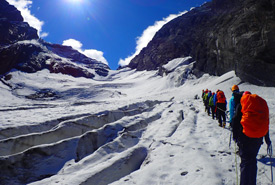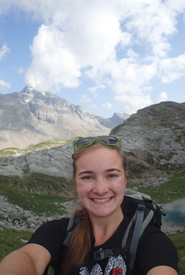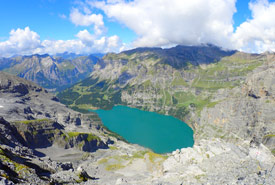Heard it from a Scout: Hiking tips for rookies

Hiking in the Swiss Alps (Photo courtesy Scouts Canada)
The worst mistake I ever made while hiking was unintentionally stepping on a fresh cow patty. I would have been less embarrassed if it hadn’t happened while leading a group of giggly international Scouts. At the time, I was guiding in the Swiss Alps and serving as an outdoor activity guide for the Kandersteg International Scout Centre in Switzerland. As a guide, I equipped groups with the necessary gear and knowledge for their treks, while safely leading them through the Alps. There were plenty of embarrassing moments during those three months, most of which involved interactions with cows or their excrement.

Scout Sarah Kallesoe leading a group through the Alps (Photo courtesy Scouts Canada)
From guiding in the Alps to my experience as a life-long Scout, here are some tried-and-true pointers for having a safe hiking adventure:
Research the trail beforehand
It’s essential that you research a trail before hiking it. As a rule of thumb, be aware of the estimated time it takes to complete the round-trip hike, the elevation and length of the trail and the most recent trail conditions report. Understanding what to expect during your adventure allows you to dress and pack appropriately, so you don’t end up bringing too much or too little. Detailed information about most Canadian trails is a quick internet search away.
Have an emergency plan
Based on the trail difficulty and the estimated round-trip duration, set an expected return time and share it with a friend or family member. If you don’t check in with them by the expected time, they should alert local authorities.
Bring at least two litres of water
Always carry water while hiking; staying hydrated is key to an enjoyable hike. As an outdoor activity guide in Switzerland, I would always make sure every group member had at least two litres of water before we began our hike.
Wear the right shoes
Mountain terrain can be very rocky and is best conquered while wearing hiking boots with strong ankle support. Wearing waterproof and supportive boots can help prevent twisted ankles on most trail conditions.
Carry snacks
If you are out for more than two hours, it’s a good idea to bring along some snacks, such as granola bars, trail mix and dried fruit.
Pack a flashlight
Even if you are planning to return by sunset, it’s always a good idea to bring a flashlight. Don’t rely on using a cellphone as a flashlight as it drains the battery and isn’t a good source of light. Instead, pack a separate flashlight with extra batteries.

View while hiking in the Swiss Alps. (Photo courtesy Scouts Canada)
First aid kit
Follow the scout motto — “Be prepared” — by bringing a first aid kit for the trail. The size of your first aid kit depends on the length of the adventure; first aid kits for multi-day hikes require more planning. For day hikes, things to include are bandages, mosquito repellent, insect-bite cream, sunscreen, tweezers, paper and pencil, antiseptic wipes, CPR face shield and latex gloves (or latex alternative).
Consider bringing hiking poles
Keep in mind that hiking downhill tends to be harder on the knees compared to trekking uphill. Consider bringing hiking poles on trails with steep elevation changes to help prevent knee injuries.
Safe and fun adventures always start with a plan. So keep that in mind on your next great adventure!
"Heard it from a Scout" is written by members of Scouts Canada’s Youth Spokesperson program. This post was authored by Sarah Savić Kallesøe.

